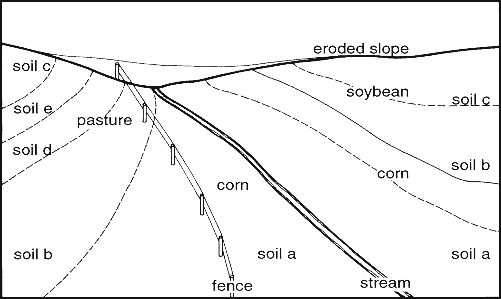
Farms or fields should be sampled according to soil areas. Different histories of crop management require separate samples even on the same soil. Eroded areas or other poor yielding spots must be sampled and evaluated separately. Samples have to be taken from each soil and crop sequence (Figure 3).
When stratified random sampling is used, the population, i.e. a field or plot, is divided into sub-populations (strata). For example, the strata may be a ridge, a slope, a low area or a level area. A simple random sample is taken from each strata.
The scientist or researcher prefers this sampling method for two reasons:
to make a statement about the sub-population
to increase the accuracy of estimates over the entire population
Since the sampler selects stratified random sampling for its accuracy, stratification must eliminate some variations caused by any sampling errors. In general, accuracy increases as stratification becomes more well defined.
To estimate the sampling error of a stratum, sample at least two units. If the stratum is kept small enough, a good estimate of error can be obtained.
One final point to keep in mind when applying this sampling technique is that the stratum is sampled in proportion to the total. If it is 20% of the total, then the number of sampling units to take from the stratum should be 20%.

Figure 3. Stratification of soils (Smith 1976, modified).